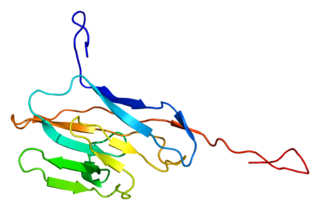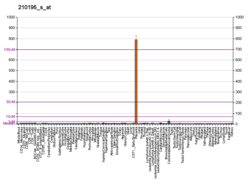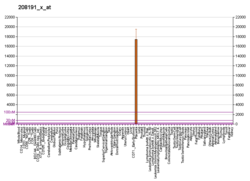Gonadotropins are glycoprotein hormones secreted by gonadotropic cells of the anterior pituitary of vertebrates. This family includes the mammalian hormones follicle-stimulating hormone (FSH) and luteinizing hormone (LH), the placental/chorionic gonadotropins, human chorionic gonadotropin (hCG) and equine chorionic gonadotropin (eCG), as well as at least two forms of fish gonadotropins. These hormones are central to the complex endocrine system that regulates normal growth, sexual development, and reproductive function. LH and FSH are secreted by the anterior pituitary gland, while hCG and eCG are secreted by the placenta in pregnant humans and mares, respectively. The gonadotropins act on the gonads, controlling gamete and sex hormone production.

Carcinoembryonic antigen (CEA) describes a set of highly-related glycoproteins involved in cell adhesion. CEA is normally produced in gastrointestinal tissue during fetal development, but the production stops before birth. Consequently, CEA is usually present at very low levels in the blood of healthy adults. However, the serum levels are raised in some types of cancer, which means that it can be used as a tumor marker in clinical tests. Serum levels can also be elevated in heavy smokers.

Angiopoietin 1 is a type of angiopoietin and is encoded by the gene ANGPT1.

Carcinoembryonic antigen-related cell adhesion molecule 1 (CEACAM1) also known as CD66a, is a human glycoprotein, and a member of the carcinoembryonic antigen (CEA) gene family.

Carcinoembryonic antigen-related cell adhesion molecule 6 (CEACAM6) also known as CD66c, is a member of the carcinoembryonic antigen (CEA) gene family..

Pregnancy-specific beta-1-glycoprotein 9 is a protein that in humans is encoded by the PSG9 gene.

Carcinoembryonic antigen-related cell adhesion molecule 3 (CEACAM3) also known as CD66d, is a member of the carcinoembryonic antigen (CEA) gene family..

Folate receptor beta is a protein that in humans is encoded by the FOLR2 gene.

Alpha-1,6-mannosylglycoprotein 6-beta-N-acetylglucosaminyltransferase A is an enzyme that in humans is encoded by the MGAT5 gene.

Pregnancy-specific beta-1-glycoprotein 3 is a protein that in humans is encoded by the PSG3 gene.

Carcinoembryonic antigen-related cell adhesion molecule 8 (CEACAM8) also known as CD66b, is a member of the carcinoembryonic antigen (CEA) gene family. Its main function is cell adhesion, cell migration, and pathogen binding.

Pregnancy-specific beta-1-glycoprotein 5 is a protein that in humans is encoded by the PSG5 gene.

Carcinoembryonic antigen-related cell adhesion molecule 7 is a protein that in humans is encoded by the CEACAM7 gene.

Pregnancy-specific beta-1-glycoprotein 4 is a protein that in humans is encoded by the PSG4 gene.

Pregnancy-specific beta-1-glycoprotein 6 is a protein that in humans is encoded by the PSG6 gene.
Pregnancy-specific beta-1-glycoprotein 10 is a protein that in humans is encoded by the PSG10 gene.

Carcinoembryonic antigen-related cell adhesion molecule 5 (CEACAM5) also known as CD66e, is a member of the carcinoembryonic antigen (CEA) gene family.

T-cell surface glycoprotein CD3 delta chain is a protein that in humans is encoded by the CD3D gene.

Choriogonadotropin subunit beta (CG-beta) also known as chorionic gonadotrophin chain beta is a protein that in humans is encoded by the CGB gene.













